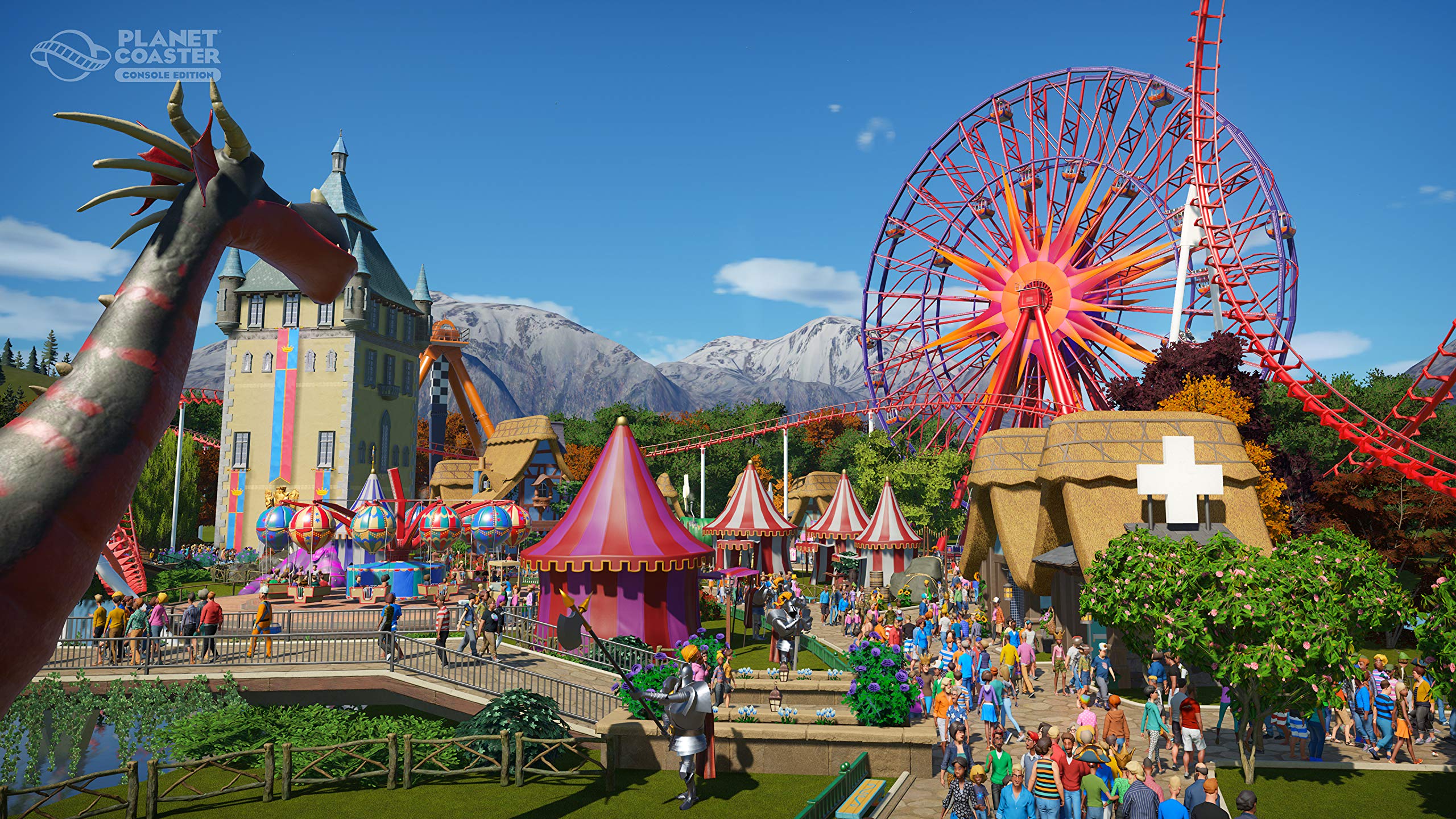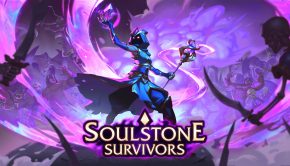Planet Coaster 2 PS5 Review
Summary:
4
Swimming in Potential
Over the years, I’ve put a lot of time into Frontier titles; I’d go as far as saying they’re probably my favourite developer. One of the titles I’ve potentially sunk the most of these hours into is Planet Coaster, which, believe it or not, is now eight years old. It might be getting on a bit, but as far as theme park building sims go, it’s pretty perfect. With that in mind, I was a little sceptical when Planet Coaster 2 was announced. From the announcement trailer (and the ridiculous amount of deep dives and footage I watched leading up to its release) the water park features looked incredible, but a lot of what was shown looked concerningly similar to the first Planet Coaster. This isn’t a bad thing, don’t get me wrong, but for a title lauded as the follow-up to one of my favourite titles, it had big shoes to fill – and some annoying problems to get right this time.
And did it? Well, kind of. Some areas are wildly improved whereas others are arguably worse, but one thing is safe to say – the new water park features are fantastic. They allow you to diversify the type of park you want to build, and you genuinely feel like you’re no longer building just a theme park, but creating a playground to challenge the likes of Disneyworld or Universal instead.
Like coasters, there’s a selection of preset pools alongside tools to create your own water features, depending on your preference, with plenty of bits and bobs that can be added to make your water park feel ‘your own’. Depending on what kind of pools you’re after, the initial presets are relatively restricting, but they offer a fair amount of variety amongst them; or at least enough to show you what your own creations are capable of. One of the first things I did was create a lazy river-type ride, utilising Planet Coaster’s additional water flow tools. As always with Planet Coaster, it took some time to get right, but when it was done, I was impressed with how well it looked (as were my very pleased guests). Similar to coaster designing, it’s not for the faint of heart – it takes a long time to get your idea just right, but if you can imagine it, you can almost definitely create a version of it. Wave pool in a cave? Go for it. Olympic-sized diving pool? Sure thing.
Of course, the star of any good water park is the flumes. The flume system works very similar to coaster making; add bends in the right places and give your slides the right height to make the water rides exciting (but not too scary or dangerous, remember). The amount of options for both coasters and water slides feels vast compared to Planet Coaster, and when it comes to water ride creation in particular, there feels like more choice than ever. From bowl-type water rides to even race slides; Planet Coaster 2 gives players such a vast selection of tools and items to work with, and it’s easy to see why this addition had to be a brand new game and not just further DLC to Planet Coaster. Frontier has really hit the nail on the head with pool and flume-making, taking what they do best in the Planet Coaster titles – coaster-making – and giving players an entirely new environment to play around in. It’s easily the best new system added to Planet Coaster, and I found myself messing about with more and more ridiculous flumes to create the ultimate water ride.
There’s also so much joy to be had just watching visitors don their swimming gear and jump into my carefully constructed water world. It felt like a nice change from the usual Planet Coaster affair, especially as visitor reactions have been reinvented for this section, making it feel even more special. Seeing my lifeguard’s dispatch rings out to struggling swimmers, watching visitors shoot off the end of a flume and land with a splash in the water – it serves as a reminder as to just how good Frontier are at making infectiously fun games.
It’s not just the water park features that are new here, either. While coasters receive only a few minor adjustments (after all, they’ve pretty much got this aspect of the game down by this point), building tools have been revamped for the better, and it’s much easier to edit and change things like scenery and coasters. Despite being a player more inclined to utilise prebuilt blueprints or those items created by other players, I still found value in things like having the ability to scale items. Being able to make something as big or small as you want offers greater, and perhaps more importantly, simpler, depth of customizability. 
Speaking of letting your creative juices flow, like in the first Planet Coaster, there’s a fantastic sandbox to play around in, as well as Frontier’s signature Franchise mode (seen in Planet Zoo), which allows you to build from scratch to then share around the world to compete with other players for the best park around. A proper campaign is also available, which, while heavy on the puns, I genuinely enjoyed playing through. It’s a fantastic way of introducing players to the game’s systems in a well-paced environment, with enough freedom throughout to still allow players to feel like they’re having input into how their parks look and run.
Personally, I’m a huge sandbox fan (I’ve never been able to get on with Franchise mode in Planet Zoo, although from what I’ve played, Planet Coaster’s version feels much better so I may shift over at some point), especially as, sometimes, I just want to turn off all requirements and restrictions and just have fun. Planet Coaster 2 is light on management elements (at least when compared to similar titles), but buildings still require things like power outputs while pools require treatment facilities. While adding these elements is still pretty simple (just drop a power supply, for example, and link it up to where it needs to go) I did find a few occasions where things weren’t powering up even when I seemed to have met all the criteria. There’s a chance I was doing something wrong, but it was likely down to me not properly understanding the worst area of Planet Coaster 2.
And that’s the new UI. It’s easily the worst I’ve experienced in a Frontier title, with simple options buried underneath endless menus, confusing button combinations and generally nonsensical decisions. For example, to open a store (as most need manual opening), you have to click the shop, and make sure you click the right part of the building (you’ll likely end up accidentally clicking a piece of a shop and not the actual shop), scroll down to edit shop, open a new menu and then click open. It might not sound like much, but it’s incredibly tedious if you have several shops to open. I often found myself completely lost with where things were, and even basic things like changing the colour of an item usually involved clicking through three or four screens. After sinking a few hours in, I did start to get used to it, but it’s still enough to put unseasoned Planet Coaster players off, and there’s some work to do to get this up to scratch with the rest of the games (mostly) usual Frontier-quality stuff.
I say mostly because let’s just get it out of the way. No, the paving system still isn’t great. Yes, it’s still an absolute nightmare to use, inconsistent and confusing but, it’s probably the best paving system that Frontier has come up with to date. It’s also worth mentioning that I’m playing a PS5 copy of the game, so no doubt the system feels much more intuitive on PC. Still, it’s so cumbersome, and even though you can now cover larger areas much easier with an improved stamp tool, I still found myself with far too many ugly edges that I ended up covering over with scenery after eventually giving up. Other tools for paving like the drawing tool don’t allow you to delete sections you have worked on if you decide to cancel while creating, meaning you have to start all over again if you make a mistake or change your mind.
I did also find things a little easy, and while I enjoyed the chill aspects of Planet Coaster I did sometimes wish things would be a little more taxing. At one point, while creating a new park on sandbox mode, I forgot to pause, so guests were still trying to get into the park, only I hadn’t built a gate yet. Even though no guests were yet to enter my, frankly incredible, wonderland, I still found myself earning money like crazy. Guests seem extra nice, and while I’m glad they’re happy with my park, I did find myself sometimes wishing it was a little more challenging to play. I guess though, you don’t play a ‘Planet’ title for the stresses of a management sim, there are plenty of other titles for that. And there are still elements of Planet Coaster 2 that will put you to the test; after all, those rides aren’t going to fix themselves, and the guests certainly can’t be held responsible for your lack of bins.
It’s worth remembering that this is Frontier. Is Planet Coaster 2 going to replace the original as my go-to park builder just yet? No, but it almost definitely will in the future. It’s early days, and to discredit the work that Frontier has put into Planet Coaster 2 would do them a huge disservice – there simply aren’t any other studios out there that push out such quality games. It’s still a way off becoming the ultimate theme park builder, but if other Frontier titles are to go by, give it a little time (and a little polish) and Planet Coaster 2 will undoubtedly be the sandbox my dreams.










